check engine LEXUS LX470 2007 Owners Manual
[x] Cancel search | Manufacturer: LEXUS, Model Year: 2007, Model line: LX470, Model: LEXUS LX470 2007Pages: 426, PDF Size: 10.95 MB
Page 4 of 426
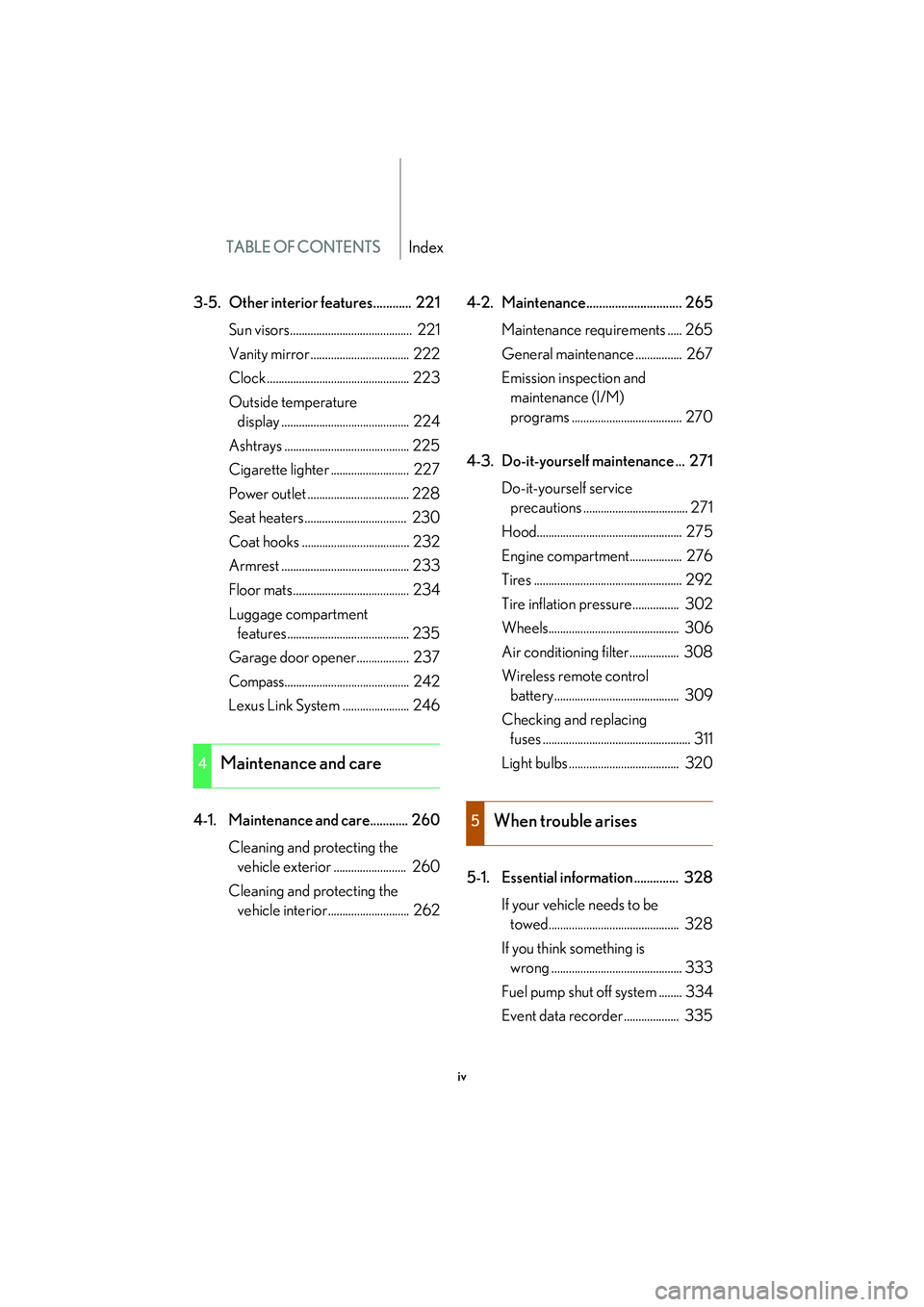
TABLE OF CONTENTSIndex
iv
3-5. Other interior features............ 221Sun visors.......................................... 221
Vanity mirror .................................. 222
Clock ................................................. 223
Outside temperature display ............................................ 224
Ashtrays ........................................... 225
Cigarette lighter ........................... 227
Power outlet ................................... 228
Seat heaters ................................... 230
Coat hooks ..................................... 232
Armrest ............................................ 233
Floor mats........................................ 234
Luggage compartment features .......................................... 235
Garage door opener .................. 237
Compass........................................... 242
Lexus Link System ....................... 246
4-1. Maintenance and care............ 260 Cleaning and protecting the vehicle exterior ......................... 260
Cleaning and protecting the vehicle interior............................ 262 4-2. Maintenance.............................. 265
Maintenance requirements ..... 265
General maintena nce ................ 267
Emission inspection and maintenance (I/M)
programs ...................................... 270
4-3. Do-it-yourself maintenance ... 271 Do-it-yourself service precautions .................................... 271
Hood.................................................. 275
Engine compartment.................. 276
Tires ................................................... 292
Tire inflation pressure................ 302
Wheels............................................. 306
Air conditioning filter................. 308
Wireless remote control battery ........................................... 309
Checking and replacing fuses ................................................... 311
Light bulbs ...................................... 320
5-1. Essential information .............. 328 If your vehicle needs to be towed............................................. 328
If you think something is wrong ............................................. 333
Fuel pump shut off system ........ 334
Event data recorder ................... 335
4Maintenance and care
5When trouble arises
Page 17 of 426

xvii
Scrapping of your Lexus
The SRS airbag and seat belt pretensioner devices in your Lexus contain explosive
chemicals. If the vehicle is scrapped with the airbags and seat belt pretensioners left
as they are, this may cause an accident such as fire. Be sure to have the systems of
the SRS airbag and seat belt pretensioner removed and disposed of by a qualified
service shop or by your Lexus deal er before you scrap your vehicle.
Leak detection pump (for the U.S.A. and Canada)
This pump performs fuel evaporation leakage check. This check is conducted sev-
eral hours after the engine is turned off. You may hear a sound coming from under-
neath the luggage compartment for several minutes, however this does not indicate
a malfunction.
CAUTION
■General precautions while driving
Driving under the influence: Never drive your vehicle when under the influence of
alcohol or drugs that have impaired your ability to operate your vehicle. Alcohol
and certain drugs delay reaction time, impair judgment and reduce coordination,
which could lead to an accident that will hurt or kill you, your occupants or others.
Defensive driving: Always drive defensively. Anticipate mistakes that other drivers
or pedestrians might make and be ready to avoid accidents.
Driver distraction: Always give your full at tention to driving. Anything that distracts
the driver, such as adjusting controls, ta lking on a cellular phone or reading can
result in a collision with resulting death or serious injury to you, your occupants or
others.
■General precaution regarding children’s safety
Never leave children unattended in the vehi cle, and never allow children to have or
use the key.
Children may be able to start the vehicle or shift the vehicle into neutral. There is
also a danger that children may injure themselves by playing with the cigarette
lighter, the windows, the moon roof, or othe r features of the vehicle. In addition, heat
build-up or extremely cold temperatures inside the vehicle can be fatal to children.
Page 108 of 426
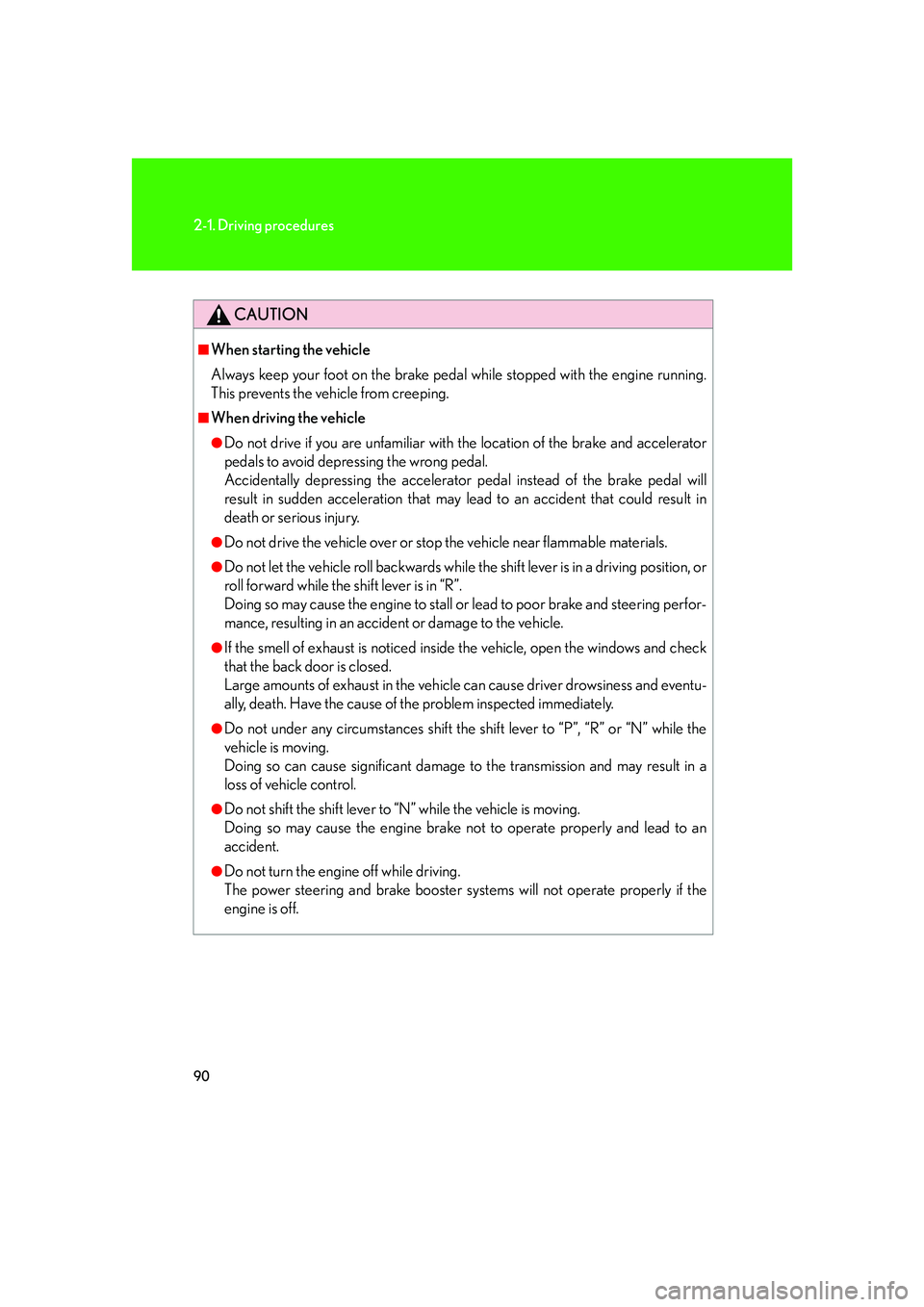
90
2-1. Driving procedures
CAUTION
■When starting the vehicle
Always keep your foot on the brake pedal while stopped with the engine running.
This prevents the vehicle from creeping.
■When driving the vehicle
●Do not drive if you are unfamiliar with the location of the brake and accelerator
pedals to avoid depressing the wrong pedal.
Accidentally depressing the accelerator pedal instead of the brake pedal will
result in sudden acceleration that may lead to an accident that could result in
death or serious injury.
●Do not drive the vehicle over or stop the vehicle near flammable materials.
●Do not let the vehicle roll backwards while the shift lever is in a driving position, or
roll forward while the shift lever is in “R”.
Doing so may cause the engine to stall or lead to poor brake and steering perfor-
mance, resulting in an accident or damage to the vehicle.
●If the smell of exhaust is noticed inside the vehicle, open the windows and check
that the back door is closed.
Large amounts of exhaust in the vehicle can cause driver drowsiness and eventu-
ally, death. Have the cause of the problem inspected immediately.
●Do not under any circumstances shift the shift lever to “P”, “R” or “N” while the
vehicle is moving.
Doing so can cause significant damage to the transmission and may result in a
loss of vehicle control.
●Do not shift the shift lever to “N” while the vehicle is moving.
Doing so may cause the engine brake not to operate properly and lead to an
accident.
●Do not turn the engine off while driving.
The power steering and brake booster systems will not operate properly if the
engine is off.
Page 109 of 426
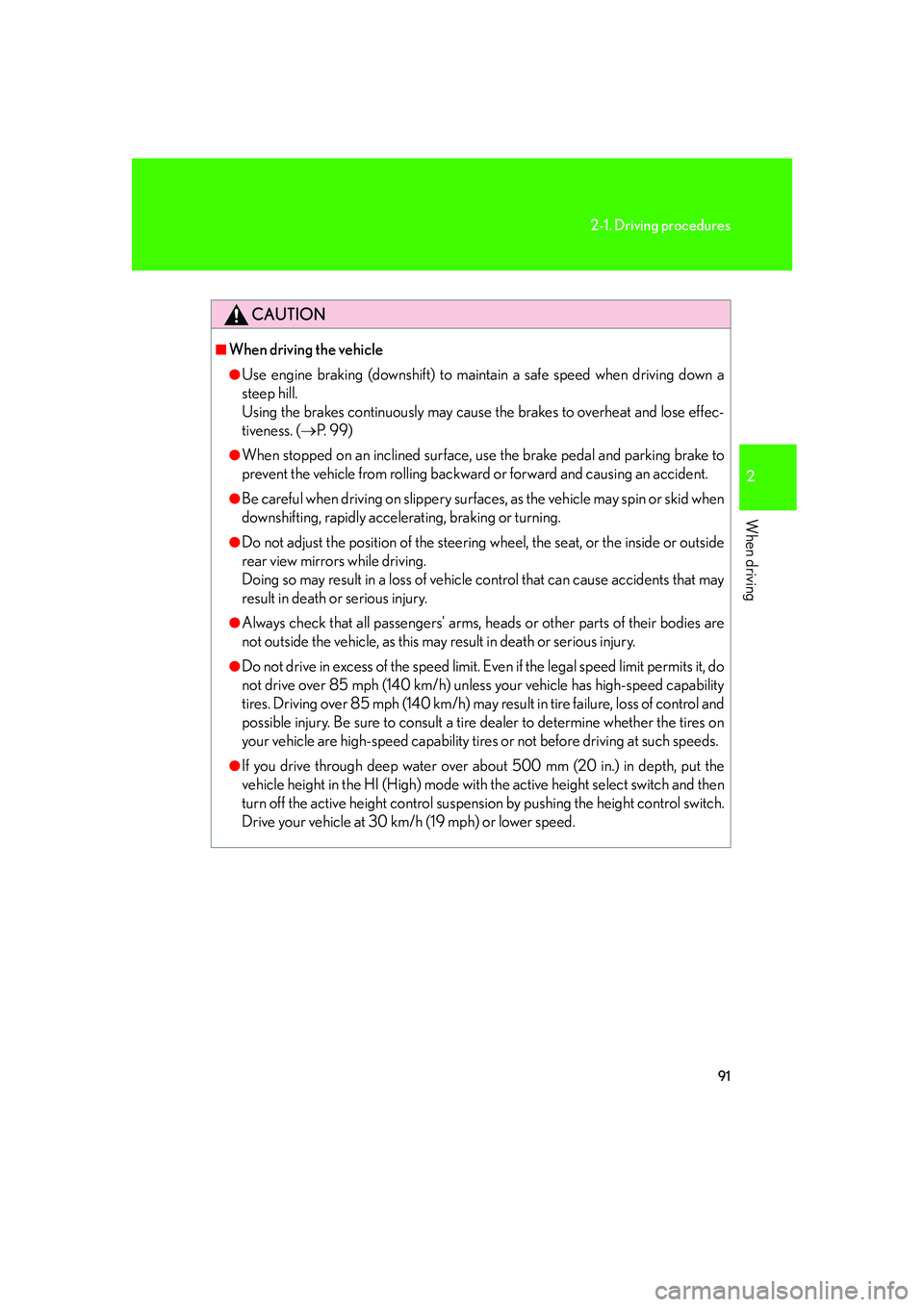
91
2-1. Driving procedures
2
When driving
CAUTION
■When driving the vehicle
●Use engine braking (downshift) to maintain a safe speed when driving down a
steep hill.
Using the brakes continuously may cause the brakes to overheat and lose effec-
tiveness. (P. 9 9 )
●When stopped on an inclined surface, use the brake pedal and parking brake to
prevent the vehicle from rolling backward or forward and causing an accident.
●Be careful when driving on slippery surfaces, as the vehicle may spin or skid when
downshifting, rapidly accelerating, braking or turning.
●Do not adjust the position of the steering wheel, the seat, or the inside or outside
rear view mirrors while driving.
Doing so may result in a loss of vehicle control that can cause accidents that may
result in death or serious injury.
●Always check that all passengers' arms, heads or other parts of their bodies are
not outside the vehicle, as this may result in death or serious injury.
●Do not drive in excess of the speed limit. Even if the legal speed limit permits it, do
not drive over 85 mph (140 km/h) unless your vehicle has high-speed capability
tires. Driving over 85 mph (140 km/h) may result in tire failure, loss of control and
possible injury. Be sure to consult a tire dealer to determine whether the tires on
your vehicle are high-speed capability tires or not before driving at such speeds.
●If you drive through deep water over ab out 500 mm (20 in.) in depth, put the
vehicle height in the HI (High) mode with the active height select switch and then
turn off the active height control suspension by pushing the height control switch.
Drive your vehicle at 30 km/h (19 mph) or lower speed.
Page 110 of 426
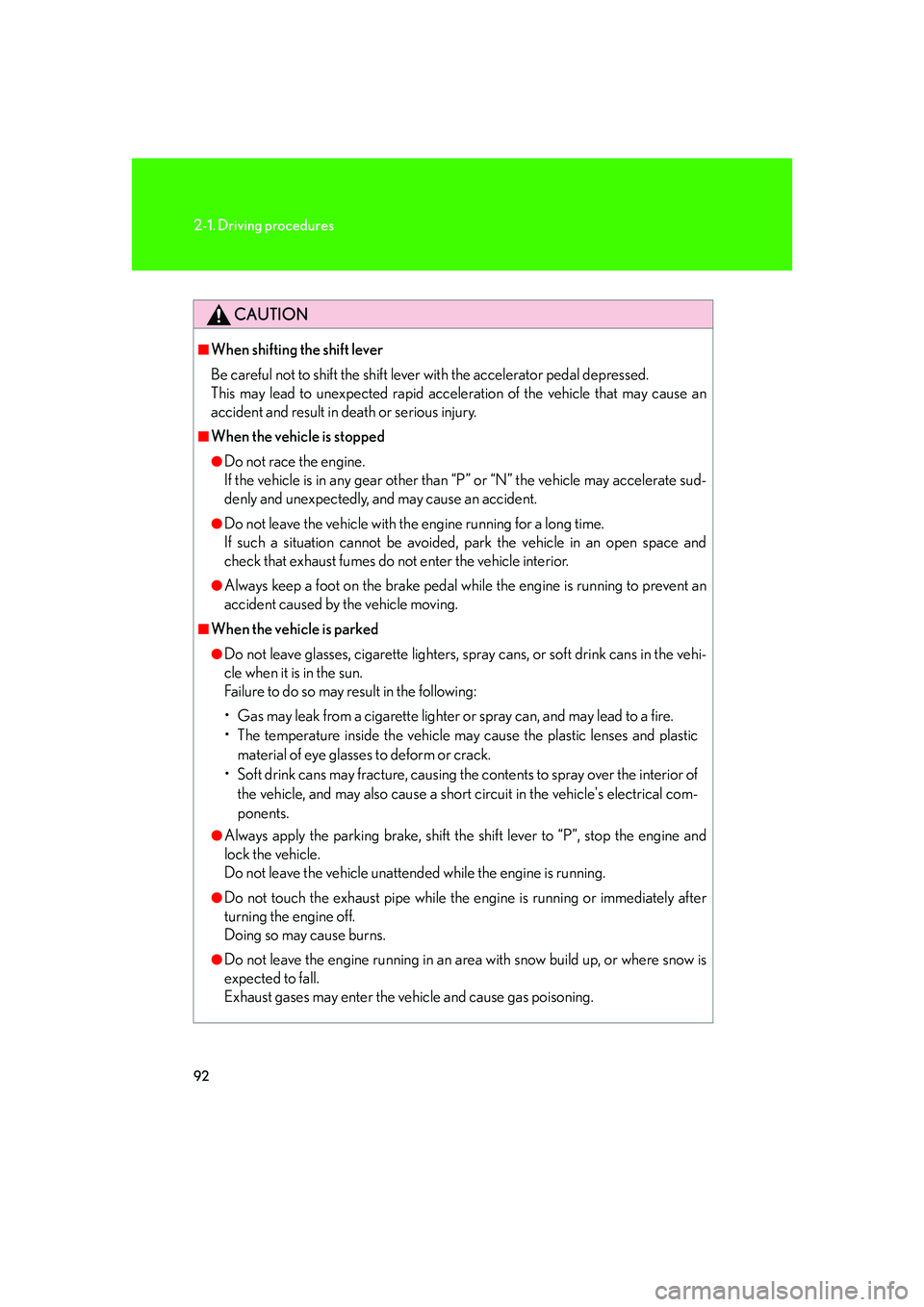
92
2-1. Driving procedures
CAUTION
■When shifting the shift lever
Be careful not to shift the shift lever with the accelerator pedal depressed.
This may lead to unexpected rapid acceleration of the vehicle that may cause an
accident and result in death or serious injury.
■When the vehicle is stopped
●Do not race the engine.
If the vehicle is in any gear other than “P” or “N” the vehicle may accelerate sud-
denly and unexpectedly, and may cause an accident.
●Do not leave the vehicle with the engine running for a long time.
If such a situation cannot be avoided, park the vehicle in an open space and
check that exhaust fumes do not enter the vehicle interior.
●Always keep a foot on the brake pedal while the engine is running to prevent an
accident caused by the vehicle moving.
■When the vehicle is parked
●Do not leave glasses, cigarette lighters, spray cans, or soft drink cans in the vehi-
cle when it is in the sun.
Failure to do so may result in the following:
• Gas may leak from a cigarette lighter or spray can, and may lead to a fire.
• The temperature inside the vehicle may cause the plastic lenses and plastic material of eye glasses to deform or crack.
• Soft drink cans may fracture, causing the contents to spray over the interior of the vehicle, and may also cause a short circuit in the vehicle's electrical com-
ponents.
●Always apply the parking brake, shift the shift lever to “P”, stop the engine and
lock the vehicle.
Do not leave the vehicle unattend ed while the engine is running.
●Do not touch the exhaust pipe while the engine is running or immediately after
turning the engine off.
Doing so may cause burns.
●Do not leave the engine running in an area with snow build up, or where snow is
expected to fall.
Exhaust gases may enter the vehicle and cause gas poisoning.
Page 113 of 426
![LEXUS LX470 2007 Owners Manual 95
2-1. Driving procedures
2
When driving
Starting the engine
]
■Turning the key from “ACC” to “LOCK”
■Ignition switch
LOCK:
The steering wheel is locked
and the key can be removed.
ACC:
S LEXUS LX470 2007 Owners Manual 95
2-1. Driving procedures
2
When driving
Starting the engine
]
■Turning the key from “ACC” to “LOCK”
■Ignition switch
LOCK:
The steering wheel is locked
and the key can be removed.
ACC:
S](/img/36/58005/w960_58005-112.png)
95
2-1. Driving procedures
2
When driving
Starting the engine
]
■Turning the key from “ACC” to “LOCK”
■Ignition switch
LOCK:
The steering wheel is locked
and the key can be removed.
ACC:
Some electrical components
such as the audio system can be
used.
ON:
All electrical components can
be used.
START
■ Starting the engine
Check that the parking brake is set.
Check that the shift lever is set in “P”.
Sit in the driver’s seat and firmly depress the brake pedal.
Turn the ignition key to the “START” position and start the
engine.
STEP1
STEP2
STEP3
STEP4
Shift the shift lever to “P”.
Push in the key and turn to the
“LOCK” position.STEP1
STEP2
Page 115 of 426
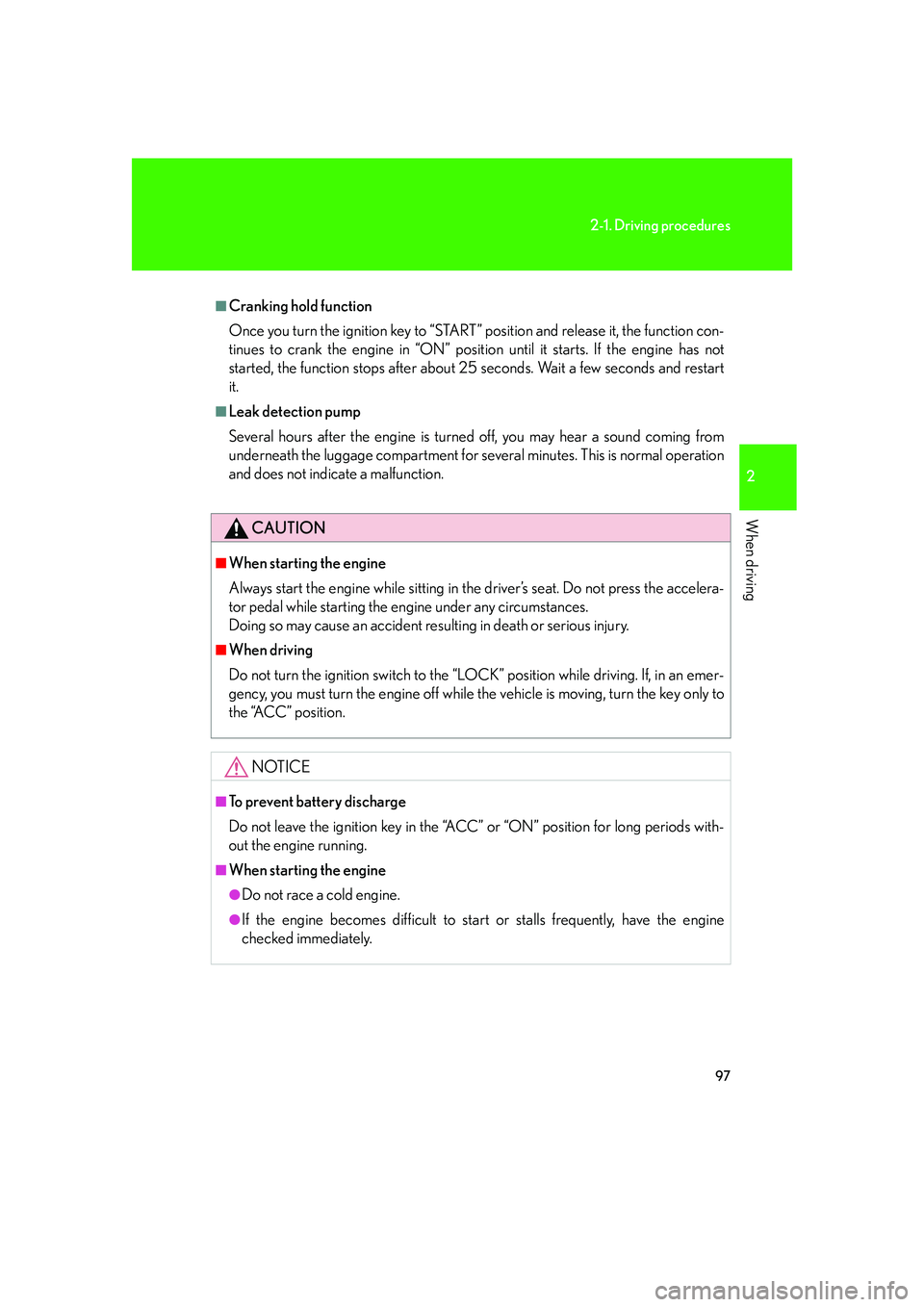
97
2-1. Driving procedures
2
When driving
■Cranking hold function
Once you turn the ignition key to “START” position and release it, the function con-
tinues to crank the engine in “ON” position until it starts. If the engine has not
started, the function stops after about 25 seconds. Wait a few seconds and restart
it.
■Leak detection pump
Several hours after the engine is turned off, you may hear a sound coming from
underneath the luggage compartment for several minutes. This is normal operation
and does not indicate a malfunction.
CAUTION
■When starting the engine
Always start the engine while sitting in the driver’s seat. Do not press the accelera-
tor pedal while starting the en gine under any circumstances.
Doing so may cause an accident resu lting in death or serious injury.
■When driving
Do not turn the ignition switch to the “LOCK” position while driving. If, in an emer-
gency, you must turn the engine off while the vehicle is moving, turn the key only to
the “ACC” position.
NOTICE
■To prevent battery discharge
Do not leave the ignition key in the “ACC” or “ON” position for long periods with-
out the engine running.
■When starting the engine
●Do not race a cold engine.
●If the engine becomes difficult to start or stalls frequently, have the engine
checked immediately.
Page 124 of 426
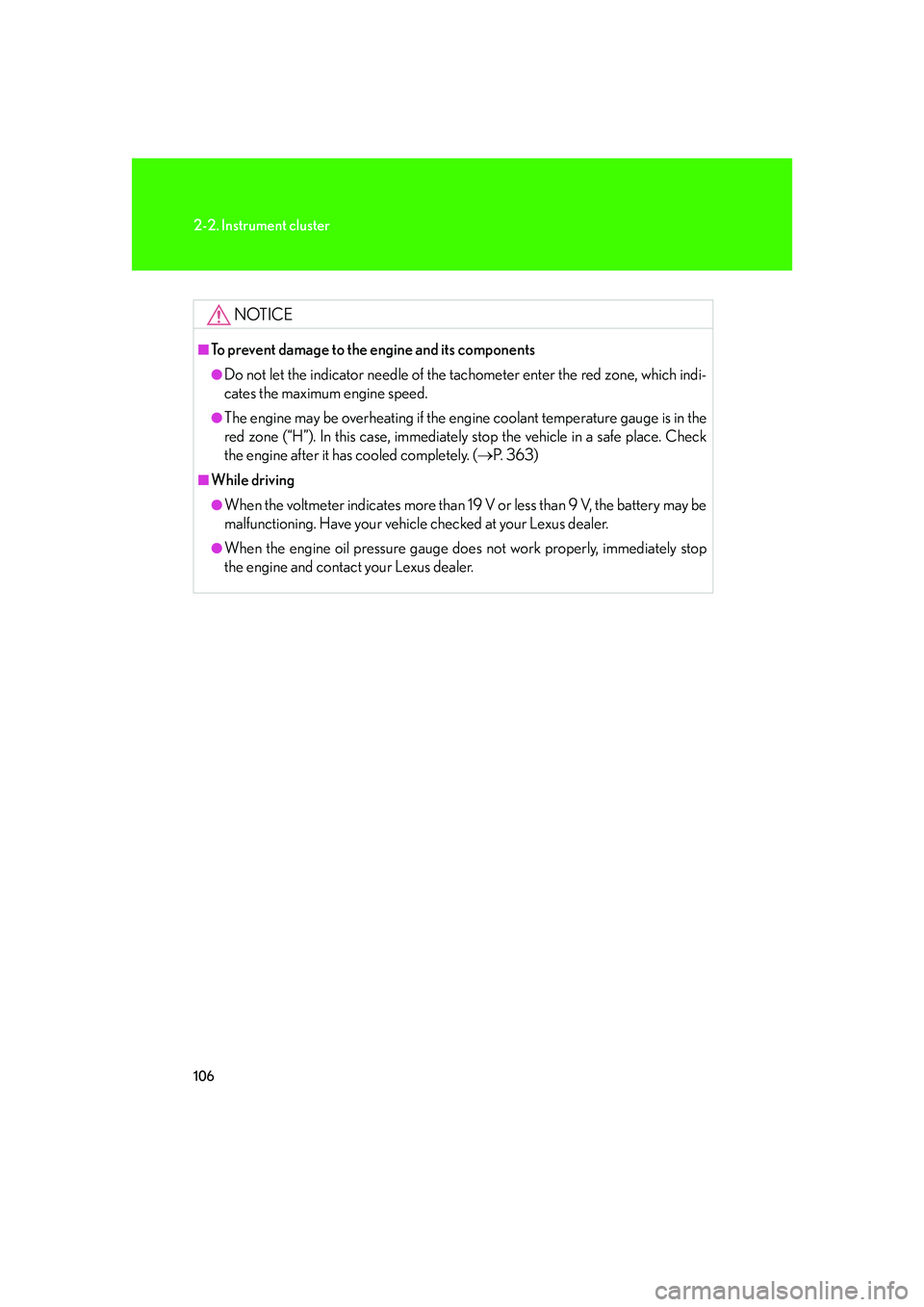
106
2-2. Instrument cluster
NOTICE
■To prevent damage to the engine and its components
●Do not let the indicator needle of the tachometer enter the red zone, which indi-
cates the maximum engine speed.
●The engine may be overheating if the engine coolant temperature gauge is in the
red zone (“H”). In this case, immediately stop the vehicle in a safe place. Check
the engine after it has cooled completely. ( P. 363)
■While driving
●When the voltmeter indicates more than 19 V or less than 9 V, the battery may be
malfunctioning. Have your vehicle checked at your Lexus dealer.
●When the engine oil pressure gauge do es not work properly, immediately stop
the engine and contact your Lexus dealer.
Page 127 of 426
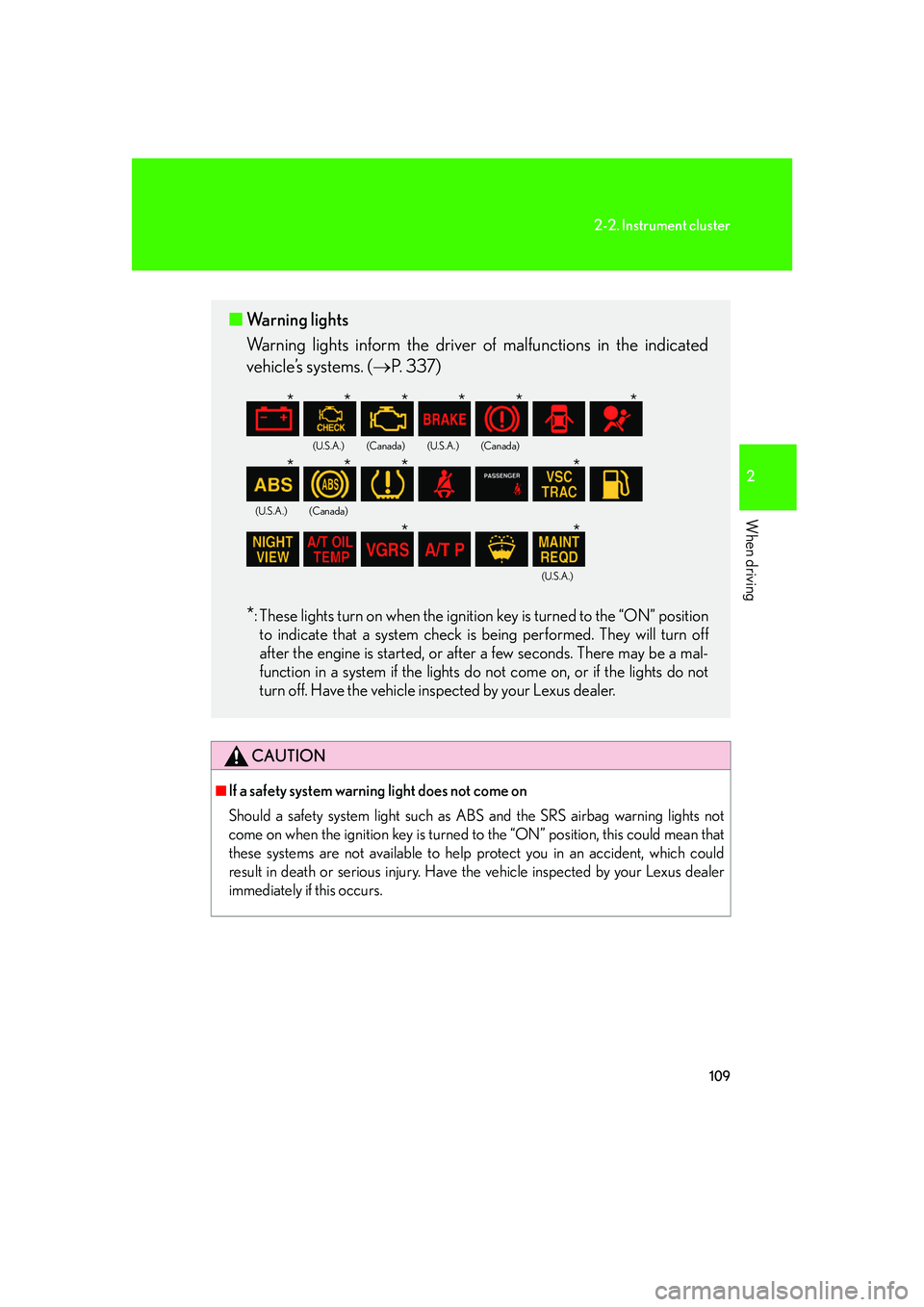
109
2-2. Instrument cluster
2
When driving
CAUTION
■If a safety system warning light does not come on
Should a safety system light such as ABS and the SRS airbag warning lights not
come on when the ignition key is turned to the “ON” position, this could mean that
these systems are not available to help protect you in an accident, which could
result in death or serious injury. Have the vehicle inspected by your Lexus dealer
immediately if this occurs.
■ Warning lights
Warning lights inform the driver of malfunctions in the indicated
vehicle’s systems. ( P. 3 3 7 )
*: These lights turn on when the ignition key is turned to the “ON” position
to indicate that a system check is being performed. They will turn off
after the engine is started, or after a few seconds. There may be a mal-
function in a system if the lights do not come on, or if the lights do not
turn off. Have the vehicle inspected by your Lexus dealer.
(U.S.A.)(Canada)(U.S.A.)(Canada)
(U.S.A.)(Canada)
(U.S.A.)
******
****
**
Page 153 of 426
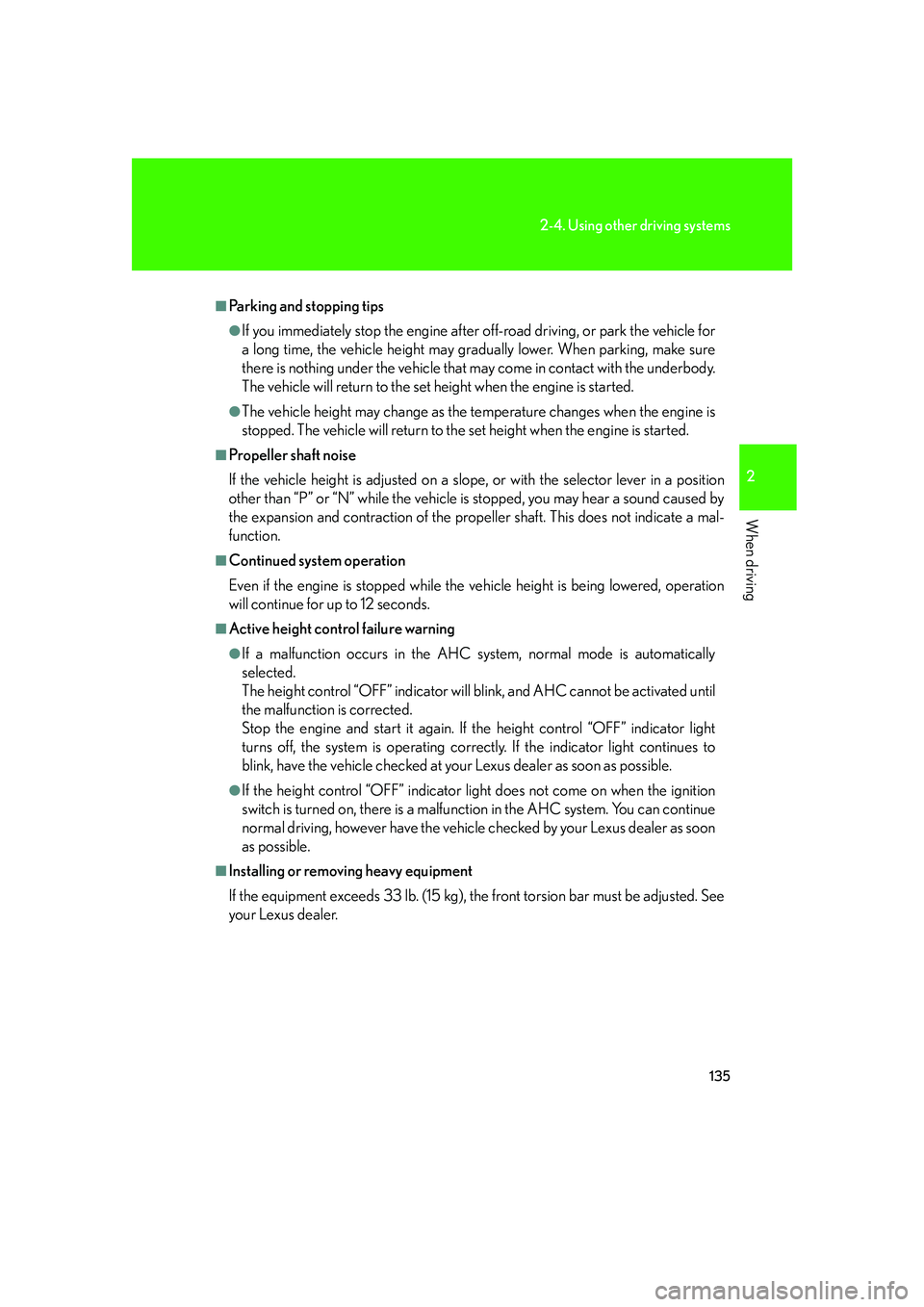
135
2-4. Using other driving systems
2
When driving
■Parking and stopping tips
●If you immediately stop the engine after off-road driving, or park the vehicle for
a long time, the vehicle height may gradually lower. When parking, make sure
there is nothing under the vehicle that may come in contact with the underbody.
The vehicle will return to the set height when the engine is started.
●The vehicle height may change as the temperature changes when the engine is
stopped. The vehicle will return to the set height when the engine is started.
■Propeller shaft noise
If the vehicle height is adjusted on a slop e, or with the selector lever in a position
other than “P” or “N” while the vehicle is stopped, you may hear a sound caused by
the expansion and contraction of the propel ler shaft. This does not indicate a mal-
function.
■Continued system operation
Even if the engine is stopped while the ve hicle height is being lowered, operation
will continue for up to 12 seconds.
■Active height control failure warning
●If a malfunction occurs in the AHC system, normal mode is automatically
selected.
The height control “ OFF” indicator will bl ink, and AHC cannot be activated until
the malfunction is corrected.
Stop the engine and start it again. If the height control “OFF” indicator light
turns off, the system is operating correc tly. If the indicator light continues to
blink, have the vehicle checked at your Lexus dealer as soon as possible.
●If the height control “OFF” indicator light does not come on when the ignition
switch is turned on, there is a malfunction in the AHC system. You can continue
normal driving, however have the vehicle checked by your Lexus dealer as soon
as possible.
■Installing or removing heavy equipment
If the equipment exceeds 33 lb. (15 kg), the front torsion bar must be adjusted. See
your Lexus dealer.